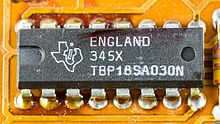Programmable read-only memory
A programmable read-only memory ( PROM ; German programmable read-only memory ) is an electronic component .
The original PROMs are no longer used. PROMs have been replaced by EPROMs , whereby there are OTP (one-time programmable) ROM components similar to the functionality of the PROMs , which use EPROM technology, but for cost reasons do not have a UV erase window and thus just like PROMs only once writable and no longer - or only by X-rays - erasable.
The difference between the PROM and the mask ROM is that the latter already receives its memory content during manufacture, which can no longer be changed, while the PROM is (once) programmable. In the delivery state, all memory cells of a PROM contain a logical 1.Memory cells that are later to output a 0 signal are programmed by vaporizing metal connections at the crossing points of the grid-like lines by specifically applying a higher voltage (programming voltage).
The problem with this technology is, in addition to the one-time programmability, which excludes later changes or makes them difficult, the metal vapor released during programming in the component housing. The precipitation of the metal vapor can lead to errors. Even if the memory content is correct immediately after the programming process, errors can occur later due to physical effects such as electromigration if metal particles conductively connect the previously programmed crossing points again.
Technically, a PROM can be viewed as a programmable logic arrangement (PLA) in which only the OR array can be programmed. The address decoder represents the preset AND matrix.
